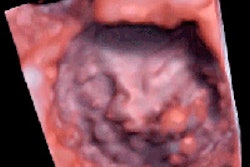SPECT myocardial perfusion imaging (MPI) can help determine whether patients with left ventricular ejection fraction (LVEF) measurements of greater than 35% have an increased risk of sudden cardiac death, according to a study in the July 13 issue of the Journal of the American College of Cardiology.
Improved treatment has helped reduce mortality from cardiovascular disease, with the implantable cardioverter defibrillator (ICD) an effective tool for preventing sudden cardiac death. But the efficacy of ICDs relies on finding the patients at greatest risk, noted a research team led by Jonathan Piccini, MD, from Duke University Medical Center in Durham, NC, and including researchers from the University of Alabama at Birmingham (JACC, Vol. 56:3, pp. 206-214).
Measurements of left ventricular ejection fraction can be used to stratify patients at risk of sudden cardiac death, but many patients who die suddenly have preserved left ventricular systolic function. In particular, patients with LVEF measurements greater than 35% have not been studied extensively, according to the authors.
"Given the magnitude of sudden cardiac deaths in patients with an LVEF >35%, there is a great need to identify risk factors in this population; unfortunately, little is known about the predictors of [sudden cardiac deaths] in patients with LVEF >35%," they wrote.
The researchers therefore investigated whether myocardial perfusion defects found on SPECT MPI studies were associated with a higher risk of sudden cardiac death in patients with LFEV greater than 35%.
Patient sample
Piccini and his colleagues reviewed patient information in the Duke Databank for Cardiovascular Disease (DDCD), which includes the past medical history and clinical course of more than 81,800 cardiovascular patients in the Duke University Health System.
Between January 1993 and December 2006, the researchers identified 4,865 patients with coronary artery disease (CAD) and LVEF greater than 35% who underwent SPECT stress-rest MPI. The median age of the patient sample was 63 years. All patients had coronary artery disease, which was indicated by stenosis of greater than 75% in one or more major coronary arteries.
The researchers defined sudden cardiac death as death within one hour of symptom onset or an unobserved death in which the patient was seen and known to be doing well within 24 hours of death. Also included in the study were survivors of aborted sudden cardiac death or resuscitated cardiac arrest.
Stress tests
Depending on their physical abilities, patients were tested either by treadmill stress or pharmacologically. A SPECT camera with multihead detectors was used with 30 seconds per projection at rest and 20 seconds per projection during stress.
SPECT MPI scans then were used to evaluate the severity of defects in each myocardial segment, rating the findings on a scale of zero (no defect) to three (severe defect). The researchers also adopted a summed stress score (SSS), which was calculated by adding the perfusion scores in all myocardial segments.
"Accordingly, the SSS incorporates both fixed and reversible defects and would equal 0 in a normal study," the authors wrote. "The SSS is an established predictor of cardiovascular outcomes, including myocardial infarction and cardiovascular death."
During follow-up of the 4,865 patients with coronary artery disease and an LVEF greater than 35%, 161 (3.3%) patients died suddenly. Among the patients who suffered a sudden cardiac death, the median LVEF was 51%. The median time to sudden cardiac death was three years.
In addition, there were 1,557 (32%) nonsudden cardiac deaths, with a median follow-up of 7.2 years.
SSS contribution
In evaluating the summed stress and myocardial perfusion scores, the researchers found that every three-unit increase in the SSS was associated with a 23% increase in the hazard ratio for sudden cardiac death.
"The addition of the SSS to the clinical history and LVEF led to improvement in the predictive power of the model," they found, with SSS accounting for 27% of the total prognostic information for risk of sudden cardiac death, while LVEF accounted for 52% of the prognostic information.
Piccini and his colleagues also noted that "further validation of these findings and prospective studies should address the role of SPECT perfusion imaging for the risk stratification of [sudden cardiac death] in patients with CAD and LVEF >35%."
The identification of patients at greater risk for sudden cardiac death also will advance the clinical benefit of an implantable cardioverter defibrillator to prevent such an occurrence.
By Wayne Forrest
AuntMinnie.com staff writer
July 14, 2010
Related Reading
Gated SPECT best indicator for cardiac events, April 13, 2009
ACC study: Most cardiac SPECT scans are appropriate, April 1, 2009
Hybrid 3D echo/SPECT technique produces better CAD imaging, February 12, 2009
SPECT MPI predicts sudden cardiac death, September 26, 2008
PET, SPECT measures of LVEF have superior predictive value, March 13, 2006
Copyright © 2010 AuntMinnie.com



















